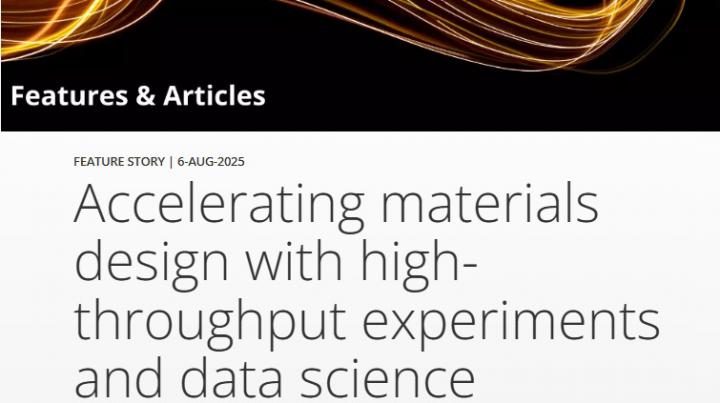Taniike Lab.
MENU
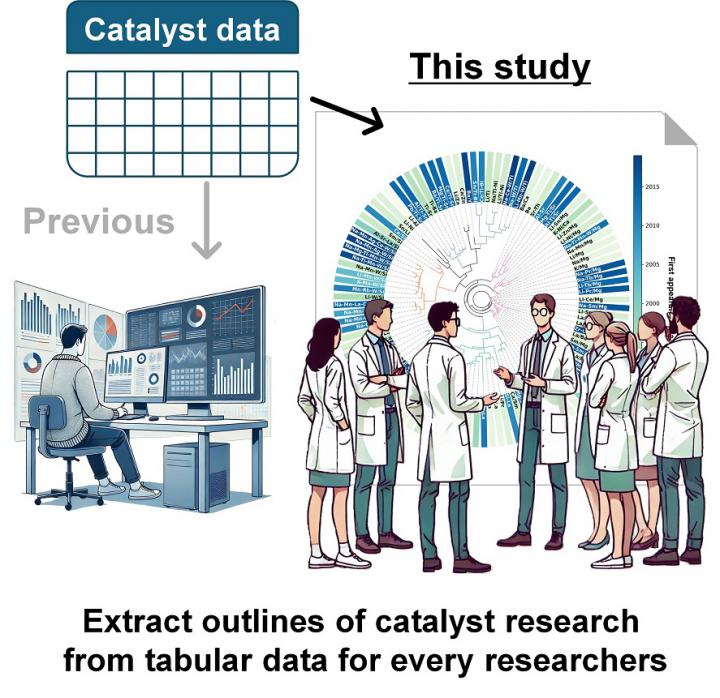
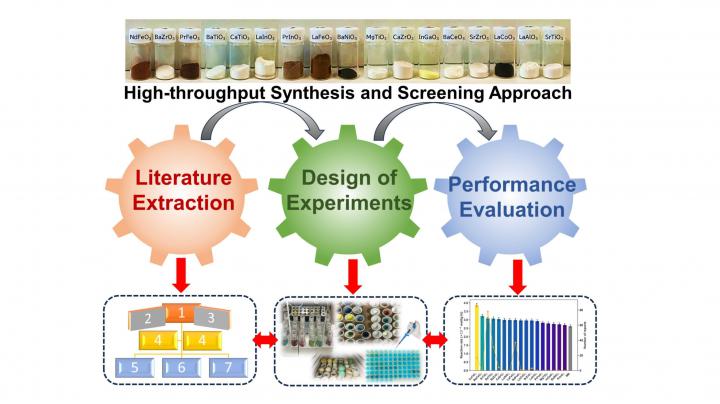
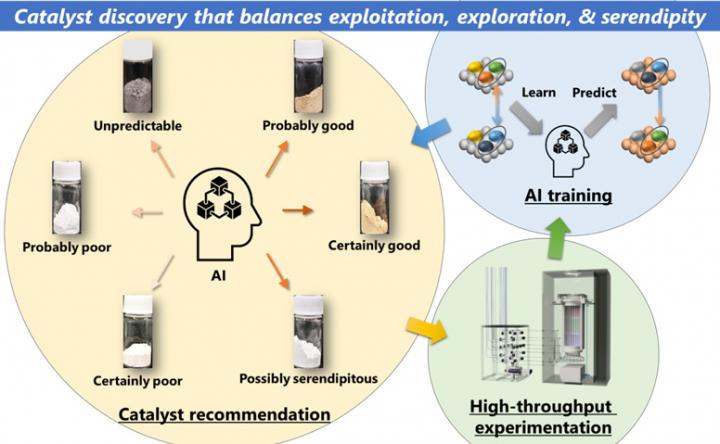



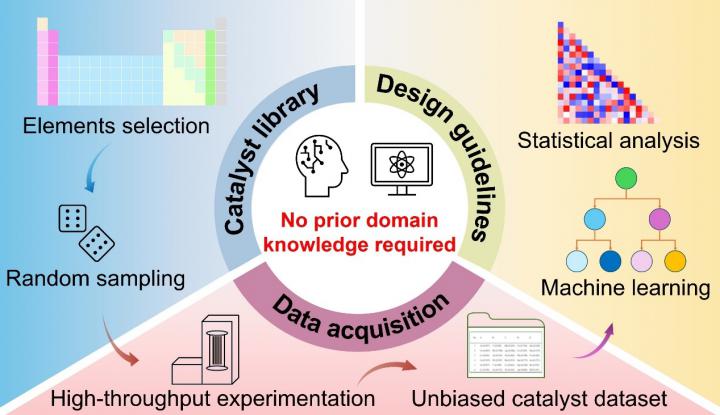






































Reserach News
2025.06.13 by 中野渡 淳 Sunao NakanowatariIn recent years, a growing number of catalyst datasets compiled from the literature have been made publicly available and actively used in data science. While these tabular datasets also contain historical insights into catalyst development, understanding such trends remains difficult in their raw form. In this study, we propose a "catalyst phylogenetic tree" to visualize the underlying design history embedded in these datasets. By grouping catalysts based on elemental combinations and mapping their physicochemical distances onto a phylogenetic tree, our method offers an intuitive overview of catalyst design lineages and trends. This versatile approach is also applicable to materials beyond catalysts.

2025.05.29 by Poulami MUKHERJEEWhat if advanced photocatalysts could be designed simply by mixing, screening, and discovering? Our high-throughput approach offers one such possibility. In this work, we propose an efficient synthesis of perovskites using citric acid, which holds promise for a wide range of applications, including environmental purification through photocatalysis.

2025.05.15 by 中野渡 淳 Sunao NakanowatariIs an unknown catalyst likely to be high-performing, low-performing, potentially either, lacking sufficient information for prediction, or seemingly low-performing but with unexpected potential (serendipity)? In this study, we developed a system capable of inferring these possibilities from existing catalyst data. Using this system, we demonstrated the potential of a data-driven, efficient, and systematic approach to catalyst development that balances the exploitation of existing knowledge, exploration of unknowns, and discovery of serendipitous outcomes.

2025.04.11 by 張 葉平 Yohei ChoPhotocatalysis involves a series of sequential steps, including light absorption, excited carrier diffusion, and surface redox reactions, making the identification of the rate-limiting step challenging. This study demonstrates that the surface imbalance of excited carriers, manifested as variations in reaction temperature, can be utilized to distinguish whether the supply or consumption of excited carriers governs the reaction rate. This finding is anticipated to not only directly enhance photocatalytic performance but also significantly improve the precision of design hypotheses that were previously often ambiguous.

2025.02.27 by 和田 透 Toru WadaMolecular catalysts for synthesizing polyethylene and polypropylene exhibit catalytic activity upon contact with activators. Methylaluminoxane (MAO) is the most widely used activator, but its structure remains unclear, hindering the understanding of catalyst activation mechanisms and the development of new activators. In this study, we analyzed the molecular structure of MAO using synchrotron X-ray total scattering and identified it as plate-like molecules with diameters of approximately 2 nm. These findings are crucial for elucidating the working mechanism of MAO and expected to contribute to the development of new activators and plastic materials.

2025.01.21 by 藤原 綾 Aya FujiwaraConventional catalyst discovery has been limited to the exploration and optimization of areas surrounding known high-performance catalysts, making it challenging to grasp the overall landscape of the design space or transfer insights across different catalyst systems. In this study, we aimed to overcome these limitations by employing two original techniques on high-throughput experimentation and feature engineering. As a result, comprehensive catalyst knowledge was obtained for the five catalyst systems applied to oxidative coupling of methane. This enabled a systematic understanding of catalyst design rules and facilitated knowledge transfer across catalyst systems during machine learning.

2025.01.05 by Wentao DUThe traditional approach to designing solid catalysts has been time-consuming and labor-intensive, relying on trials and errors guided by prior knowledge and hypotheses. Recently, combining machine learning with high-throughput experimentation, researchers are exploring uncharted chemistry without preconceptions or biases. Our study exemplifies this shift, focusing on methane dry reforming—a key reaction for sustainable energy and greenhouse gas mitigation. We constructed an unbiased dataset of 256 γ-Al2O3-supported catalysts, each with random combinations of 17 elements from the periodic table. This eliminates assumptions about optimal elements, allowing us to discover surprising trends and catalysts through machine learning.

2024.04.24 by 谷池 俊明 Toshiaki TaniikeInternal donors (IDs), organic Lewis bases, have been the major drivers in the evolution of the Ziegler-Natta catalyst for propylene polymerization. However, the discovery of new ID molecules remains a highly empirical and demanding task. Artificial intelligence methods offer promise but lack a quality dataset. Here, the teams of JAIST and U-Naples collaborate to establish an integrated high-throughput workflow encompassing catalyst synthesis, propylene polymerization, and polypropylene characterization. Its application to an ID library generated a robust and consistent dataset, allowing to establish accurate machine learning models via molecular fingerprinting and feature selection. This synergy will lead to accelerated research and development of the Ziegler-Natta catalyst.

2024.01.19 by Joao Marcos DA SILVEIRAInternal donors are essential organic components of the heterogeneous Ziegler-Natta catalyst in producing high-quality polypropylene. However, their capability of shaping the catalyst structure during its preparation has been long overglanced, though it constitutes the basis of generating desired active sites. To address this issue, we applied our previously established method combining density functional theory and a genetic algorithm to the non-empirical structure determination of the catalyst. The result is an unprecedented view on the internal donor-induced support reconstruction at a molecular level, that shows how donor’s adsorption preferences and capabilities cause a drastic increase in the stereospecific Ti species and dictate the diversity in the Ti local environment, possible cause of the widely known effect of donors on the molecular weight distribution.

2024.01.12 by 谷池 俊明 Toshiaki TaniikeThere is a growing interest in leveraging machine learning to accelerate research and development of practical materials such as catalysts. This involves the use of data to train machines and variables (descriptors) to predict the functions of materials. Particularly, for accurate prediction, descriptors that efficiently and comprehensively incorporate factors influencing the functions are essential. We developed an automatic feature engineering technique that works with only a small amount of training data without requiring any prior knowledge. It generates and screens a large number of features (hypotheses) to select descriptors, essentially serving as hypothesis screening. The technique outperformed traditional techniques in the prediction accuracy, regardless of target catalysis, and was able to pinpoint various high-performing catalysts from a vast pool of catalysts.

2023.12.06 by 柳山 鏡 Kyo YanagiyamaPhotocatalytic reactions are gaining attention as a method for water purification. One of the challenges in this field is the lack of practical research and application knowledge under realistic environmental conditions. In this study, we have developed a new high-throughput screening method capable of conducting photocatalytic reactions in parallel across 132 experiments, leading to significant insights into environmental water purification using visible light-responsive photocatalysts. The research revealed that specific ions in environmental water significantly reduce the activity of the catalysts. Furthermore, to develop effective catalysts in environmental waters, we incorporated 15 types of noble metal nanoparticles into the photocatalysts. As a result, it was discovered that metal nanoparticles, like Au and Pt, which possess high work functions and oxidation resistance, convert environmental ions into active species and demonstrate high activity.

2023.11.12 by Son Dinh LeThe development of three-way catalysts is accelerated by integrating multimetallic catalysts and high-throughput experimentation. Our approach involves the preparation of multimetallic catalysts through the deposition of multielement nanoparticles synthesized via a parallelized hot-injection method. These catalysts are evaluated in parallel using a home-made high-throughput reactor. The research, with only three batches of experiments, underscores the importance of Pt group metals, while shedding light on the potential of more cost-effective and earth-abundant metals like Cu, Co, Ni, and Fe as promising alternatives.

2023.09.16 by Tejkiran Pindi JayakumarIn data-driven materials research, the presence of a large, consistent, and unbiased dataset is essential. We have achieved materials informatics to create such data through high-throughput experimentation. This study corresponds to our next challenge. One of the essentials of solid catalyst design is the combination of multiple components to effectively catalyze chemical reactions comprising many elementary reactions. However, predicting synergistic combinations is highly challenging. In the conversion of ethanol into butadiene, a catalysis of practical importance in the bio-refinery, we successfully achieved a 14-dimensional exploration, optimizing catalyst compositions consisting of 14 different elements, through the combination of high-throughput experimentation and machine learning. This approach allowed us to discover a number of high-performance novel compositions in a short period of time.

2023.06.30 by 筑間 弘樹 Hiroki ChikumaWe previously achieved non-empirical structure determination of catalyst nanostructures by combining a genetic algorithm and DFT calculations. However, this has been hampered by the significant increase in both computational cost and parametric space along with the system size. Here, we utilized previously accumulated DFT calculation results to construct a high-dimensional neural network potential capable of reproducing the DFT results rapidly and accurately. By applying the built potential, we successfully determined the primary particle structure of a Ziegler-Natta catalyst with its size and coverage comparable to those of real catalysts. The obtained structure exhibited structural features consistent with experimental observations.

2022.08.02 by 高棹 玄徳 Gentoku TakasaoA combination of a genetic algorithm and local geometry optimization enables non-empirical structure determination for complex materials such as solid catalysts. However, premature convergence in the genetic algorithm hinders the structure determination for complicated systems. Here, we implemented a distributed genetic algorithm based on migration from a structure database for avoiding the premature convergence, and thus realized the structure determination for TiCl4-capped MgCl2 nanoplates with experimentally consistent sizes. The obtained molecular models are featured with a realistic size and non-ideal surfaces, representing primary particles of Ziegler-Natta catalysts.

2022.05.17 by 瀧本 健 Ken TakimotoSynergistic combinations of stabilizers are essential for imparting durability to polymeric materials, but the low throughput of durability tests and the large number of combinations have hindered systematic research. In this study, we have established a novel protocol for high-throughput experimentation, which is based on solution film casting on microplates and absorbance measurement using a microplate reader. The developed protocol was combined with a genetic algorithm to explore stabilizer formulations for photo-induced yellowing inhibition of transparent plastics. The obtained data, amounting to seven years, were analyzed to successfully derive formulation design guidelines.

2022.03.02 by Dongzhi ZhuDue to its high breakdown voltage and low dielectric loss, biaxially oriented polypropylene (BOPP) is mainly used for thin-film capacitors in automobiles. Here, BOPP nanocomposites with dispersed titanium dioxide nanoparticles were prepared and their dielectric properties were investigated in detail. The nanocomposites exhibited permittivity far beyond the theoretical estimate, and we found out that the key is at the nature of the intermediate layer called interphase. Research on BOPP nanocomposites has been hardly reported due to the difficulty of stretching PP nanocomposites. By using the own reactor granule technology, we overcome the technical challenge, and obtained very important knowledge about thin-film capacitors.

2021.11.01 by 和田 透 Toru WadaThe analysis of Ziegler-Natta (ZN) catalysts is difficult due to its complex and heterogeneous nature. We have attempted to clarify the origin of the active structure of ZN catalysts by applying multifaceted characterization techniques, which track the evolution of the starting material to the final catalyst. The linkage between the polymerization performance and the formation of the active structure, like the nuc leation and growth of the δ-MgCl2 support, the types and abundance of chemical species present on the surfaces, and impurity formation and removal is important in rational design of catalysts with desired performance.

2021.10.28 by Hui YouMetal-organic framework (MOF)-based thin-film nanocomposite (TFN) membranes are promising for addressing the permeability-selectivity tradeoff in desalination. Key challenges have been identified at the dispersion and chemical stability of MOFs as well as at the interfacial bonding with the polymeric matrix. Here, we successfully demonstrated that polydopamine (PDA)-coating of MOF nanoparticles can address all these problems at once. Indeed, it almost doubled the permeability and improved the fouling resistance of the membrane without sacrificing the selectivity.

2021.06.21 by 中野渡 淳 Sunao NakanowatariOxidative coupling of methane (OCM) is a catalytic reaction that directly converts methane to ethylene. The main difficulty of this reaction is based on the fact that methane has a higher chemical stability than ethylene, i.e. strict tradeoff between methane conversion and selectivity to ethylene production. In the past, we acquired catalyst big data comprising of the OCM performance of 300 randomly selected catalysts under 135 reaction conditions. Here, we made the analysis of this big data from two viewpoints, i.e. suppression of ethylene oxidation under harsh conditions, and methane conversion under mild conditions. Thus extracted two kinds of heuristics were successfully combined to develop catalysts which equip both the activity and selectivity.

2021.01.27 by Thanh Nhat NguyenHeterogeneous catalyst development has typically been driven by trial and error, as combinatorial catalyst design that results in high performance is hard to predict. Accumulation of such empirical efforts is regarded as the anthropogenic bias in catalyst informatics, which unpleasantly binds machine learning to known experiences. Here, non-empirical catalyst design is attempted based on the combination of random sampling, high-throughput experimentation (HTE), and data science. 300 quaternary catalysts are randomly sampled from a materials space consisting of 36,540 catalysts, where their performance in relation to oxidative coupling of methane (OCM) is systematically evaluated by HTE. Machine learning is then applied to the resulting bias-free dataset in order to learn the underlying patterns in catalyst performance. The trained machine successfully predicts novel quaternary combinations for OCM with an accuracy of 80%.

2020.11.09 by 高棹 玄徳 Gentoku TakasaoA multisite nature i.e. a distribution in the produced polymer, is an essential feature of the Ziegler-Natta catalyst, which is the mainstream catalyst for industrial polyolefin production. However, the origin of the multisite nature is still unclear. We performed a series of machine learning-aided structure determination for TiCl4-capped MgCl2 nanoplates of different sizes and chemical compositions, and obtained a million structures in the course of the structure determination. Based on the analyses and simulation, a new hypothesis was successfully proposed for the origin of the multisite nature of the Ziegler–Natta catalyst.

2020.10.14 by Nhan Ton Nu ThanhChemical exfoliation of graphite is an effective method for a mass production of high-quality graphene, where the choice of a solvent is crucial in the graphene yield and quality. In this study, a number of exfoliating solvents and solvent combinations were newly identified via systematic screening along with the development of a novel machine learning technique based on the evidence theory. A synergistic effect among effective functional groups was also exploited. This study was performed in collaboration with Prof. Dam's Group, JAIST.

2020.06.30 by 谷池 俊明 Toshiaki TaniikeFinding promising ones from a huge number of combinations is an important target of materials science. The combinatorial use of a genetic algorithm and the HTP-CLI that can simultaneously evaluate the stability of 100 specimens enabled us to find efficient formulations by selecting 10 from 22 stabilizers. The lifetime of polypropylene was successfully elongated by 3.5 times with 50 days (the data amount corresponds to 5.5 years when acquired by the conventional method). Furthermore, mutually synergistic and antagonistic stabilizers were identified by analyzing the relationship between the formulations and their performances. It is shown that the method is not only able to solve combinatorial problems efficiently, but also useful for knowledge extraction.

2020.06.25 by 和田 透 Toru WadaTo figure out the structure-performance relationship (SPR) in a solid catalyst is difficult because multiple structural features (chemical composition, particle size, pore size, etc.) influence each other and simultaneously affect the performance in a complicated manner. In this study, a number of compound features were created from the structural parameters obtained by various analytical methods, and the features that best explain the catalytic performance were extracted in order to elucidate the SPR in the Ziegler-Natta catalyst.

2020.03.05 by 和田 透 Toru WadaIn Ziegler-Natta catalysts for polyolefin production, catalyst macroparticles are made up of smaller nanoparticles, termed primary particles. The structure of the primary particles has been long controversial due to technical difficulties, but we successfully determined it based on synchrotron X-ray total scattering experiments and simulation.

2020.02.22 by Thuy Phuong Nhat TranA chemiluminescence (CL) method detects the occurrence of a reaction through counting photons that are emitted in the course of the reaction. Here, we studied the CL emission during catalytic oxidation CO and C3H6, and successfully demonstrated a potential of the CL method as a rapid screening tool for catalytic converters. This study provides a firm basis towards the development of a high-throughput catalyst screening technique based on CL imaging.

2019.12.25 by Thanh Nhat NguyenAn attempt to accelerate materials research and development with the aid of data science is called "materials informatics (MI)". We have developed a high-throughput instrument which automates the collection of 4000 catalysis data per day, and thereby acquired 12000 data in three days. Visualization and machine-learning analysis of this catalyst big data enabled us to improve the yield of methane oxidative coupling. Though MI is conceptually well established, its outcome largely relies on the presence of a proper dataset in terms of quantity and quality. The present breakthrough successfully demonstrated that research of decades can be implemented within one month or even one week.

2019.02.18 by 高棹 玄徳 Gentoku TakasaoAll computational chemistry requires a molecular model of materials as an initial structure, and the accuracy of the calculations heavily depends on the model. The construction of molecular models relies on physicochemical inference or limited experimental clues; therefore, a method for non-empirical structure determination is desired. We developed a methodology for the non-empirical structure determination based on the combination of a genetic algorithm and density functional calculations, and its application was demonstrated for MgCl2/TiCl4 nanoplates in relation to industrial Ziegler-Natta catalysts. We found that the chemisorption of TiCl4 induced reconstruction of MgCl2 by stabilizing {110} surfaces and TiCl4 exhibited distributed adsorption states as its intrinsic thermodynamic nature.

2019.01.08 by Xi ZhangAlong with the miniaturization and lightweight design of electronic device components, greater demands are constantly raised on polymeric materials having high thermal conductivity and low density. We proposed a novel strategy based on the reactor granule technology (RGT) and immiscible polymer blends with a co-continuous structure. The RGT afforded uniform dispersion of in-situ generated aluminum oxide nanoparticles in polyproplene, and this guaranteed the migration of nanoparticles to the interface of the co-continuous structure when blended with polyolefin elastomer. Such selective localization at the interface effectively improved the thermal conductivity.

2018.10.31 by 谷池 俊明 Toshiaki TaniikeWe have developed a nano-dispersed MgO/MgCl2/TiCl4 core-shell catalyst to afford 1 μm-sized ultra-high molecular weight polyethylene (UHMWPE) particles through catalyzed polymerization. The obtained particles exhibited significantly improved processing properties compared with conventional particles.

2018.03.30 by Nhan Ton Nu ThanhHybridization of titanium dioxide (TiO2) with graphene is a promising strategy to reinforce a photocatalytic ability of TiO2 under visible light, for which most of previous researches employed graphene oxide (GO) as a starting material of graphene in cost of some disadvantages. Here, we have presented a novel GO-free route to synthesize TiO2/graphene nanocomposites, starting from the graphene dispersion in titanium alkoxide. The dispersion was then directly used for the sol-gel reaction, affording TiO2/graphene nanocomposites with promising features including excellent morphology for the transfer of photoexcited electrons from TiO2 to graphene, a trace amount of defects on graphene sheets, and a significant extension of the absorption edge into the visible light region. Thus obtained TiO2/graphene nanocomposite exhibited the excellent catalytic activity in photodecomposition of methylene blue under visible light.

2017.10.31 by Ashutosh ThakurA bridging catalyst is a catalyst to conceptually bridge two extreme ends of catalysts, i.e. molecular catalysts with well-defined but less functional features and solid catalysts with multifunctional but ill-defined features. Here, we present a bottom-up strategy to equip multiple functions at a molecular precision , which involved the synthesis of well-defined polynorbornene supports with different contents of aryloxide ligands at their side chain, and subsequent grafting of a half-titanocene precursor to confine a predefined number of active centres in a nano-sized random coil of polymer chains. Ethylene polymerization revealed synergistic activity enhancement for these polymer-supported catalysts compared to their molecular analogues.

2017.09.27 by Thuy Phuong Nhat TranCovalently assembled graphene oxide frameworks (GOFs) have gained growing attention in gas absorbance and water purification. In this study, we synthesized Pd nanoparticles (NPs) inside the gallery space of a GOF (Pd@GOF) linked with diboronic ester. The resultant Pd NPs were not only uniformly dispersed but also firmly confined in the framework, so as to exhibit excellent catalytic activity and recyclability in a Suzuki-Miyaura cross-coupling reaction. This is an interesting contribution to demonstrate effective utilization of graphene in catalysis.

2017.09.04 by Qiagedeer AirongA reactor granule technology is a technique to prepare polymer nanocomposites having an excellent dispersion of inorganic nanoparticles, in which the nanoparticles are in-situ fabricated using the porosity of polyolefin reactor powder. So far, the technology was applied for metal hydroxides and oxides (e.g. magnesium hydroxide for flame retardation, aluminum oxide for heat release, and etc.), this study firstly proven advantages of the technology for polyolefin/noble metal nanocomposites. The obtained nanocomposites exhibited a number of attractive features arising from the inclusion of noble metal nanoparticles (silver or gold) that included antibacterial and non-linear optical properties.

2017.08.25 by 馬場 竜希 Ryuki BabaIn spite of its simple constitution, the Phillips catalyst can produce polyethylene having unique structural features in terms of branches and molecular weight distribution. Though the specialty of the Phillips catalyst is likely attributed to a multisite nature of chromium species supported on silica surfaces, the multisite nature itself has made it difficult to clarify the role of each chromium species in ethylene polymerization. Polyhedral oligomeric silsesquioxanes (POSS) with three dimensional siloxane bonds and unique cage-like molecular structures can be regarded as a model compound for silica surfaces. In this study, we synthesized a series of POSS-supported molecular catalysts having uniform chromium structures. The catalysts were utilized to study a relationship between the structure of chromium species and its catalysis in ethylene polymerization. The obtained knowledge was proven to be useful in improving the Phillips catalyst.

2017.05.26 by Bulbul MairaPolymer nanocomposites are an emerging class of hybrid materials due to their potential to offer enhanced properties and functionalities. In designing performant nanocomposites, a prerequisite is the realization of uniform dispersion of nanoparticles against their strong propensity to the agglomeration, which becomes increasingly problematic at an elevated loading of the nanoparticles. Specifically, there have been few strategies to disperse more than 10 wt% of oxide nanoparticles in hydrophobic polyolefins as the most widely used thermoplastic. We have successfully established a simple and versatile solution to the said problem based on the confinement of inorganic precursors in the porosity of reactor granule of polyolefins and subsequent in-situ generation of dispersed oxide nanoparticles. The resultant nanocomposites with oxides exhibited excellent mechanical properties, permittivity and thermal conductivity owing to highly filled but highly dispersed nanoparticles.

2017.04.13 by 谷池 俊明 Toshiaki TaniikeWe have developed an in-house 24-parallel reactor system to realize the parallel synthesis of support materials for Ziegler-Natta catalysts for the first time. The developed system enabled parallel synthesis of twenty four magnesium ethoxide as support materials with excellent reproducibility and morphological quality comparable to a conventional glassware experiment. By the addition of organic/inorganic compounds called “structure modulators” during the synthesis, a library of support materials with diverse structures was obtained, which will be utilized for equipping a catalyst library and eventually for elucidating the structure-performance relationship.

2017.01.10 by Anh T.N. DaoOwing to its exceptional mechanical properties, spider silk has attracted great attention as a potentially robust structural material. However, the inherent fragility of proteins to high temperature or humidity becomes a critical problem for industrial applications. We have systematically studied the degradation mechanism of recombinant spider silk at elevated temperature. Multilateral characterization combined with correlation coefficient approach endowed the first comprehensive view for the degradation of recombinant spider silk, where the oxidation played a pivotal role.

2016.12.26 by 谷池 俊明 Toshiaki TaniikeIn recent years, it was reported that laminated graphene oxide sheets shows extremely selective permeation for water. Here, we report that a small amount of functionalization introduced on graphene sheets significantly affects the chemoselectivity of the permeation for resultant membranes.

2015.12.08 by 谷池 俊明 Toshiaki TaniikeWe have succeeded to enable 24 parallel synthesis of support materials for olefin polymerization catalysts based on an in-house developed multipurpose reactor. Fast screening is realized with morphological control and high reproduction abilities.

2014.10.11 by 谷池 俊明 Toshiaki TaniikeA high-throughput chemiluminescence imaging instrument has been featured in a JAIST homepage (http://www.jaist.ac.jp/news/update/2014/post-424.html).

2014.07.29 by 相原 亮一 Ryoichi AiharaA program to determine structures of metal nanoparticles without any pre-knowledge by means of combined genetic algorithm and density functional calculations. The figure shows structure determination for Au nanoclusters.

2014.06.04 by 浜本 拓哉 Takuya HamamotoSolid catalysts for polycondensation prepared from titanium alkoxide and silane coupling agents. The philicity of surfaces can be tailored for improved performance.

2014.03.31 by 荒谷 尚樹 Naoki ArataniThe movie for the degradation of polypropylene, which was observed by our high-throughput chemiluminescence imaging instrument. The lifetimes of 100 samples can be evaluated by only one measurement.

